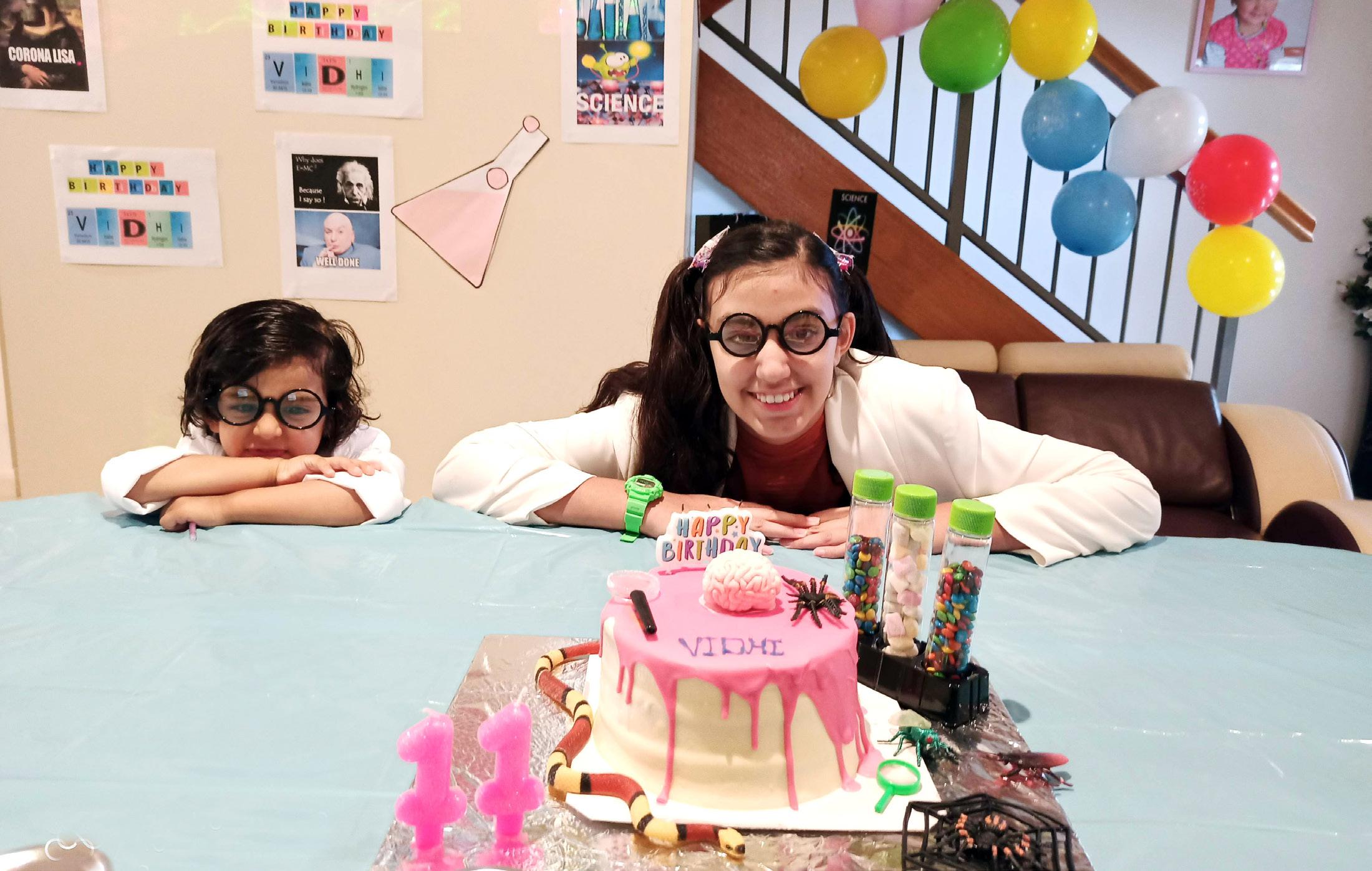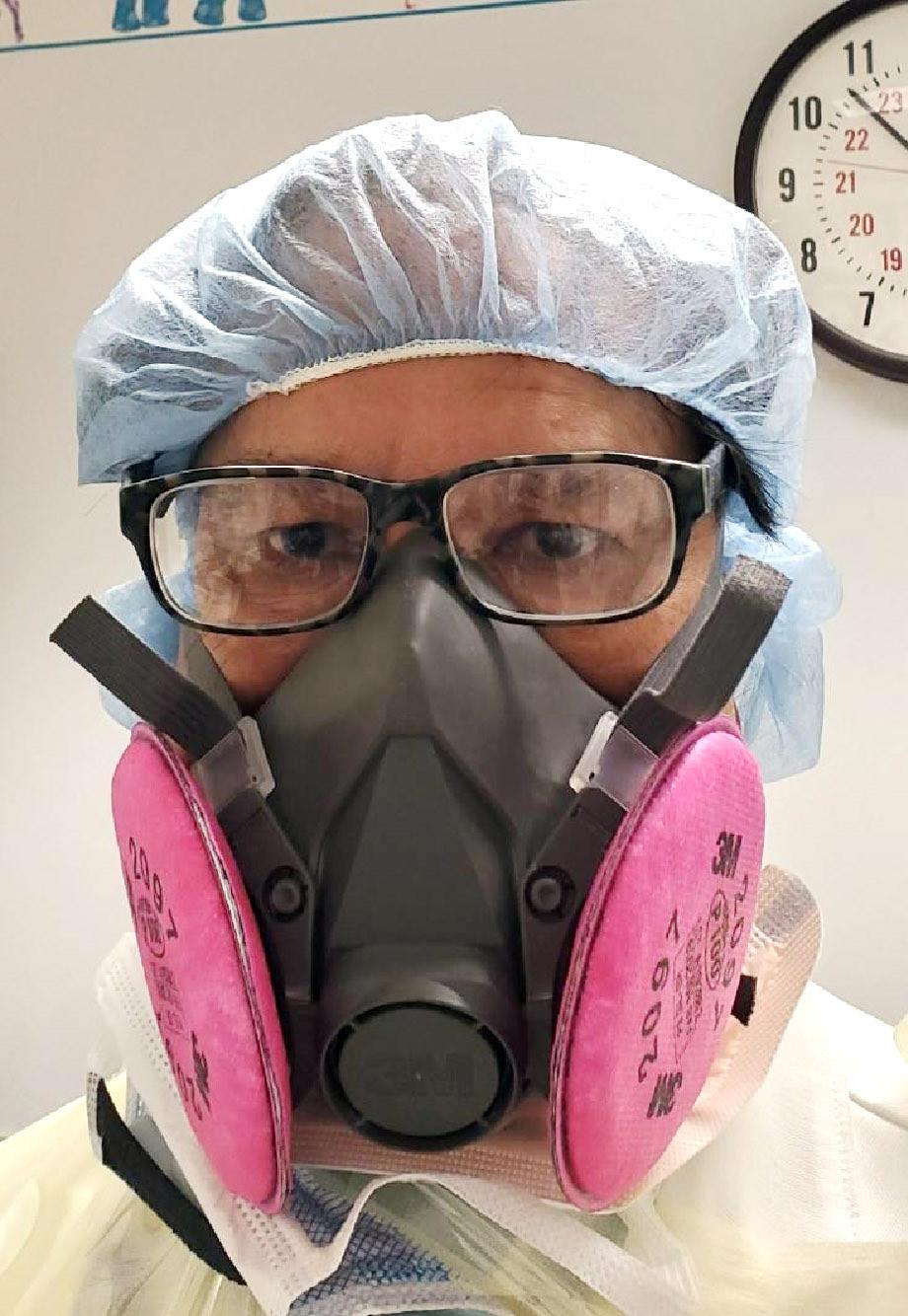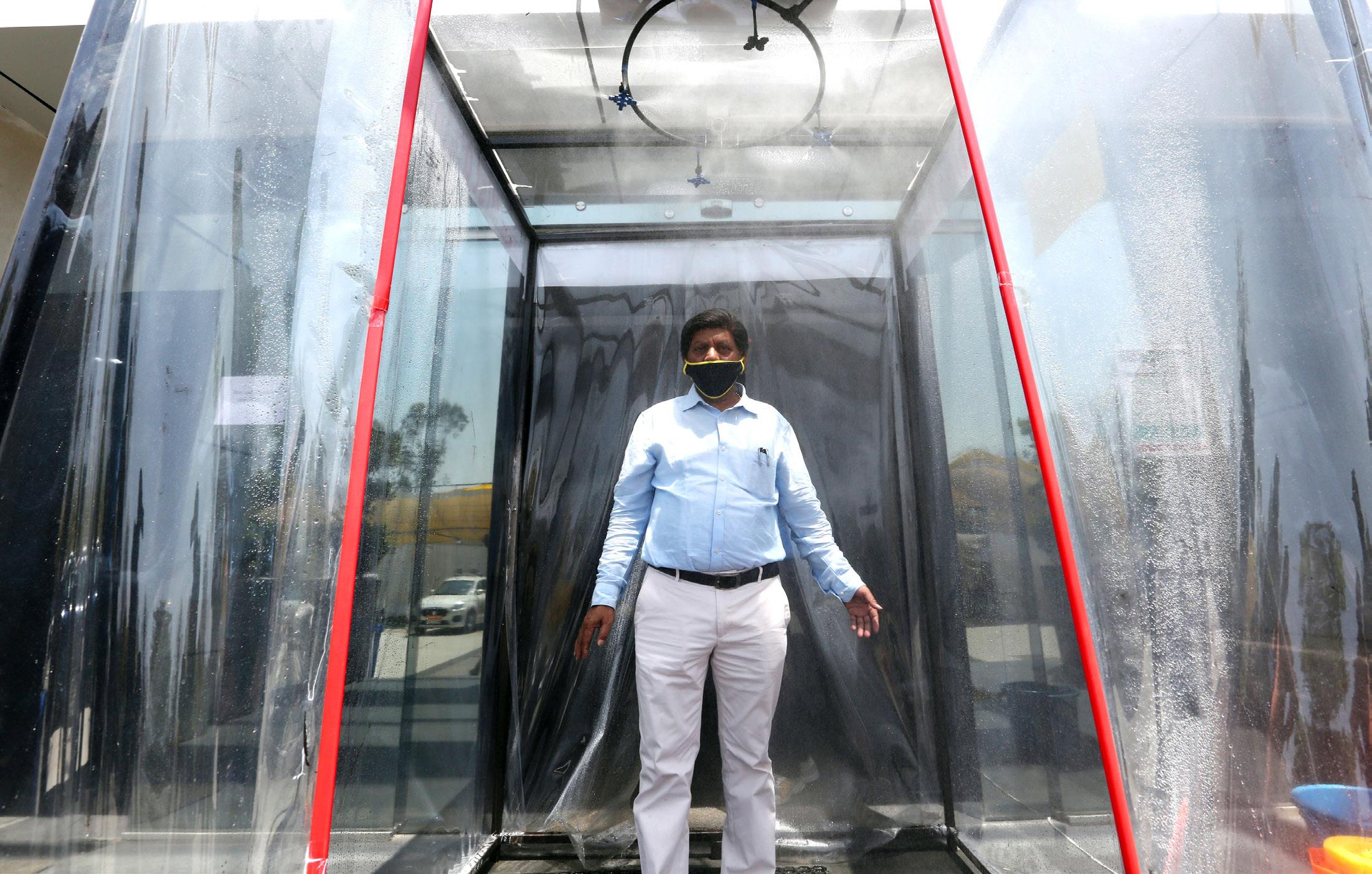
14 minute read
BIRTHDAYS ONLINE
from 2020-04 Sydney
by Indian Link
Social distancing doesn’t have to dampen your big day
Whether you’re a big fan of birthdays or not, it’s a day of fun and best wishes from loved ones. With social distancing measures significantly narrowing options to go bar hopping or throw a party, how are people celebrating their big days?
For 24-year-old Aishwarya Reddy, a HR professional with EY, the day began with a cake delivery on behalf of her colleagues while they worked from home. And since her birthday fell on the same day as Ugadi (Telegu New Year) on 25 March, she decided to dress up for the occasion.
“My parents always gift me new clothes on this day,” she told Indian Link. “Since I didn’t have to go to the office, I spent my birthday in a saree this year!”
In the evening, she gathered with her four flatmates for drinks and a unique birthday twist: social-distancing karaoke. Maintaining the 1.5 metre distance recommendation, the friends performed all the latest Billboard hits in their living room.
“I’d send you a video, but you’d want to mute it!” she exclaimed with a laugh.
Earlier this month, Nidhi Kaushik and her husband had booked Armidale Bowling Club for the ‘mad scientist’ themed birthday party of their 11-year-old daughter Vidhi. When stage-1 lockdowns by the federal government closed these public spaces, they decided to shift the party to their own home for a small gathering.

Two days after sending out messages about the change in venue, stage-2 lockdown came into effect. Not letting it come in the way of their daughter’s birthday, the Kaushiks came up with a fun solution.
“We decorated our house in a science theme and invited all Vidhi’s friends online,” Kaushik said, “We showed them live science experiments, played birthday games, danced, and cut the cake. All the kids loved it so much that they want to do it more often.”
Instead of birthday presents, the Kaushiks requested their guests to inspire at least one donor from their family to donate blood when the current COVID-19 crisis ends. It is a cause close to their heart ever since they lost their young child to leukaemia.
Of course, virtual birthdays aren’t just for the younger crowd.

Four months ago, Zia Chaney had big plans for a weekend getaway with the girlfriends to commemorate a friend’s 50th birthday. When lockdowns in India forced them to stay indoors, she came up with a unique proposition – a cocktail party hosted on Zoom.
“We were five couples, so there were ten of us on call although we all live in the same city. We dressed up, poured ourselves a drink in our living rooms, and talked for almost an hour,” she said. “It was nice to see everyone, and the birthday girl felt really special.”
Zia and her friends hope to recreate the virtual catch-up more frequently, especially as the lockdown has provided more free time for these working professionals.
“It’s something to look forward to when you are house-bound to this extent. Otherwise you hardly get to see other human beings,” Zia said.
Adityaveer Singh’s 25th birthday falls on the last day of India’s 21-day lockdown.
An assistant manager at Cushman & Wakefield Bangalore, Singh initially had birthday plans with two friends who were flying down from Delhi. With all domestic flights cancelled, he will have to make do.
“If I can’t throw a house party, I’ll just have to use the app,” he joked.
He refers to House party, a social networking app that has become very popular this last month. Allowing for video chatting with a group of up to eight people, the app’s unique feature is push notifications to all friends when a user ‘joins the party’ (opens the app).
Also, it has games like Trivia and the Ellen DeGeneres-inspired Heads Up. Friends can jump in and out of ‘rooms’ to meet new people – like a house party.
“Maybe my birthday can actually be fun at home,” Singh said.
Rhea L Nath
New York City was clearly not prepared for this,says
Indian-American doctor on COVID-19 frontlines
"It's horrible, horrible… people are dying in the emergency room (ER)," said an Indian-American doctor on the frontlines of the COVID-19 pandemic, describing the grim conditions at hospitals here where patients are lined up in the hallways, freezer trucks are parked outside to store bodies and the ambulance crews received orders to not bring in cardiac arrest cases they couldn't revive.
On the night of 2 April, as the confirmed coronavirus cases in New York City reached 51,809 and death toll 1,562, Dr Krishan Kumar told IANS that the hospitals were not prepared for the magnitude of the pandemic and were running out of beds and even basic supplies like masks.
Kumar, who works in the ERs of two hospitals, in the city's Brooklyn and Queens boroughs that are hard-hit by the pandemic, said,“People are staying in the ER for hours together. Many times people are dying in the ER. There is no floor space upstairs (to move them). There are no beds open.”
The starkest reminder of the crisis is the order issued by the city to Emergency Medical Service (EMS) ambulance staff to not bring in people suffering cardiac arrest if they cannot resuscitate them in the field.
“When the EMS brings the patients to the ER, they are either dying or nearly so there is no more CPR (cardiopulmonary resuscitation) in the ER,” Kumar said.
For the younger doctors it is very traumatic to see this and they are deeply affected, he said.
A professor of emergency medicine in the New York College of Osteopathic Medicine, who was formerly the medical director of the Fire, Police, Emergency Medical Services Academy and trained the city's first-line responders, Kumar is bringing his expertise on health emergencies to city hospital ERs in the time of crisis.
He is also the president of the New York chapter of Association of American Physicians of Indian-Origin.
The number of infected people in the city, the epicentre of the pandemic in the US, has been increasing alarmingly, and the city scrambled to increase the bed capacity
Kumar, who has been an emergency doctor for 48 years, 36 of them in the New York City area, said the city was clearly not prepared for it.
Already “people are lying in the hallways, we are lining people there,” he said.
Field hospitals are being set up on the lawns of the Central Park, in a convention centre and the Billie Jean Tennis Centre where the US Open is played.
In addition, a Navy hospital ship has been brought to the city and 20 hotels are to be taken over for hospital use.
In the Brooklyn hospital where Kumar works, he said,“By next week we will have a tent outside the hospital (and) we will start seeing patients in the tent. It is coming to that stage now.”
Given the conditions inside the hospital, he said the tent would be “much safer. Inside the hospital the same air is being recirculated. The tent will have good air flow, make things much better.”
Hospitals lack personal protection equipment (PPE) and medical staff have held protests at some hospitals.
“There are not enough masks, and if you are given one, you have to keep it for a week,” Kumar said.
Other vital equipment like respirators are in short supply, with Governor Andrew Cuomo demanding 30,000 of them from the federal government, which had only 20,000 in emergency stock. Kumar blamed city and state leaders for the debacle.

“Ventilators are a basic necessity and they should have had spares - it's common sense, it is like when you drive a car, you keep a spare wheel; it is basic.”
“You have 10 million people in the city (metro area). People are living on top of each other that could lead to a health crisis like this and because of this there should have been emergency preparedness by the Mayor or the Governor. They knew all this,” he added.
The lessons of the last big tragedy to strike the city, the 9/11 terrorist attack, happened not long and “they did not learn any lessons from that”, he added.
“They are blaming (President Donald) Trump, that he is not delivering. Why are you blaming him when you knew this was the hub of all the world, that is New York City. Don't you think we should be ready 24/7 for the emergencies?”
US Medical team translates COVID-19 information to 30 Indian languages
A team led by a first-year Indian-American medical student from the Harvard Medical School has launched an initiative to help immigrants in the US with information regarding the coronavirus pandemic by making it available in 30 different Indian languages.
Led by Pooja Chandrashekar, the team of over 150 medical students is developing COVID-19 fact sheets and translating them into 30 languages including Hindi, Gujarati, Telugu, Malayalam, Bengali, Punjabi, Tamil, Marathi and Urdu.
“As the COVID-19 pandemic is burgeoning, there has been a real lack of accessible health information available in different languages,” Chandrashekar explained.
“The goal of the project is to translate accessible COVID-19 information into different languages that we then provide to community-based organisations and clinics,” she said.
Through this initiative, the team hopes they can empower certain populations, especially those who are most vulnerable, to know when and how to seek care if they show symptoms or require assistance.
Chandrashekar's team is developing and translating fact sheets on important topics like COVID-19 Prevention, COVID-19 Management, COVID-19 for Children, and COVID-19 for Pregnant Women.
Besides Indian languages, the fact sheets are being translated into other languages like Spanish, Mandarin Chinese (Simplified), Mandarin Chinese (Traditional), Farsi, French, Arabic, Filipino, Korean, Malay, German, Russian, Vietnamese, Italian, Portuguese, Armenian, Creole, Swahili, Navajo, Indonesian and Greek.
India to get $1B emergency funding from World Bank
The World Bank has announced that India will receive $1 billion in emergency financing to fight the COVID-19 pandemic.
The assistance will support better screening, contact tracing, and laboratory diagnostics, procurement of personal protective equipment, creation of new isolation wards, the bank said.
It is the bulk of the first package of $1.9 billion fast-track aid that was approved by the Board of Executive Directors under a fast-track programme.
The rest of the aid will go to 24 other countries and the bank said that new operations are moving forward in over 40 countries. Initial approvals include $82 million to Ethiopia, $20 million to Cambodia, $20 million to Ecuador, $100 million to Afghanistan, and $200 million to Pakistan.
Overall the bank said that it expects to deploy up to $160 billion over the next 15 months to help countries protect the poor and vulnerable, support businesses, and bolster economic recovery.
In addition, the bank is working to redeploy resources in existing projects worth up to $1.7 billion.
World Bank Group President David Malpass said,“We are working to strengthen developing nations’ ability to respond to the Covid-19 pandemic and shorten the time to economic and social recovery.”
Indian businessman donates building for quarantine in Dubai
An Indian business based in Dubai has donated one of his buildings to be used as a quarantine centre for people infected with the coronavirus. Ajay Sobhraj, founder and chairman of Finja Jewellery, announced the donation in a letter to the Dubai Health Authority (DHA) titled ‘To support and give back to the city that cares’.
Calling Dubai his home for over two decades, Sobhraj donated his building in Jumeirah Lake Towers to be used in the country’s strategy against the pandemic.
The building spans 77,000 square feet and can accommodate up to 400 people. To meet necessary health and safety standards for a quarantine centre, the building underwent maintenance like deep cleaning, sanitisation and air conditioning servicing. These standards were confirmed by the Dubai Media Office.
“I believe that in such challenging times, it is imperative for the community to come together and support the country we reside in to overcome this pandemic,” Sobhraj said. “I am extremely pleased to offer my assistance to the government during this critical period and support the city that has continued to contribute to my success and growth for the past 25 years.”
The country is currently amid a 10day national sterilisation program aimed at sanitising all public facilities, streets, public transportation and metro service, as a precautionary measure to contain the spread of coronavirus.
Ir I Er E Fli R Stranded Passengers
National passenger carrier Air India has mobilised massive resources to operate international charter and cargo flights.The airline repatriated stranded foreigners from India and also brought back critical medical cargo from Shanghai.
All these flights are being operated adhering to all safety protocols laid down by the DGCA, the airline said in a statement.
Air India is scheduled to operate 18 charter flights to fly back German, French, Irish and Canadian nationals stranded in India amid the nationwide lockdown, as requested by their respected embassies.
While the Germans and French will be flown to Frankfurt and Paris, the other two nationalities will be taken to Heathrow in London from where Canada and Ireland (governments) would be making further travel arrangements for them, the airline stated.
On a special Air India flight that flew out stranded European and Canadian citizens from Mumbai,all crew members including the pilots wore the mandatory COVID-19 coveralls for over 20 hours at a stretch (to/ fro and ground time at Frankfurt). They will now remain in self-quarantine for 14 days.
Chartered flights started from March 31 with German nationals flying to Frankfurt. Earlier, AI had ferried Israeli nationals to Tel Aviv as well in a chartered flight.
In the first week of April, Air India commenced cargo flights between Shanghai and Delhi, carrying vital medical cargo.
Air India has been instrumental in rescuing stranded Indians (mainly students and pilgrims) from China, Japan and Europe.
Indian-American teen raises funds for sanitation kits for the homeless
An Indian-American teenager in California is raising funds to provide sanitation kids for the homeless community. Shaivi Shah, a sophomore at Tesoro High School in Rancho Santa Margarita, California, wanted to provide help after constantly hearing about all of the catastrophes the coronavirus has been causing.
“Because of its rapid growth, all types of people globally are being affected, especially the homeless community. They lack sanitation, money and basic necessities, especially during this time where remaining clean and germ-free, is crucial,” she explained.
Also, the shortage of hygienic products and the continuous price increase is another hurdle these people are facing, she added.
According to the New York Times, about 50 per cent of the homeless population is 50 or older which means they are at most risk for this virus causing severe health problems, Shah said.
For those reasons, the teen came to compile low-cost sanitation kits to be distributed to homeless people. The kits include hand sanitizer, hand soap, lotion, and a reusable mask.
The 15-year-old has already delivered 150 kits to four different homeless shelters. She raised these funds through a GoFundMe page online. Since starting the campaign, her page has raised nearly $1,600 with a goal of raising $2,000.
“My hope is to expand this project and reach the eyes of many citizens so that I can not only donate in different parts of California but also other states that are in tremendous need,” she added.
Supreme Court employees contribute partial salaries for PM CARES Fund
Employees of the Supreme Court of India have donated parts of their salaries to form a corpus of Rs 1.06 crore towards the PM Citizens’ Assistance and Relief in Emergency Situation (PM CARES) Fund as the country fights the pandemic.
With the exception of class IV employees, other officers of the court have come together for the cause of humanity said a circular issued by the apex court. Gazetted officers will contribute three days’ salary, non-gazetted employees will give two days’ salary, and non-clerical employees will donate one day’s salary.
All 33 Supreme Court judges, too, donated Rs 50,000 each towards the PM CARES Fund. Justice N V Ramana, who is scheduled to become Chief Justice in April 2021, contributed Rs 1 lakh along with Rs 1 lakh each to similar funds managed by the chief ministers of Andhra Pradesh and Telangana.
Justice S Ravindra Bhat contributed food packets to migrant workers stranded at the border of the National Capital Region (NCR) after the three-week lockdown was announced.
Many members of the legal fraternity are coming forward with contributions, such as senior advocate Rakesh Dwivedi who pledged Rs 1 crore to the PM CARES fund.
Taj Group to provide rooms for medical personnel
Rooms in seven Taj Hotels will now be provided to medical staff combating the coronavirus pandemic in Mumbai, Goa, and Noida. An official spokesperson for the Indian Hotels Company Limited (IHCL) which runs the Taj Group of hotels confirmed this, emphasising the company’s commitment to the medical fraternity.
“During these trying times, we at IHCL are keenly aware of our responsibilities towards our community,” the spokesperson said, explaining that the company deeply values the contributions of the medical community and will continue to work with them and local authorities as the country navigates the ongoing health crisis.
Several medics and paramedics have already posted pictures of their comfortable stays at these hotels on social media after a long day of working at the frontlines of the pandemic.
The hotels include Taj Mahal Palace and Taj Land’s End in Mumbai, Ginger Noida City Centre, and Ginger Madgaon in Goa.
Through this initiative with hotels close to medical facilities, medics can cut down on commute time and not worry about spreading germs back to their families.

‘Doodh Duronto Special’ to ensure supply of essential commodities
In a bid to maintain the supply of the essential items across the country, Indian Railways recently dispatched a “Doodh Duronto Special” with 2.4 lakh litres of milk from Andhra Pradesh to Delhi.
The train leftReninguntastation in Andhra Pradesh to Hazrat Nizamuddin in Delhi along with 23 tonnes of mangoes and 23 tonnes of muskmelons as well as two parcel vans.
Utmost precaution was taken while loading the train, an official said.
Services of passenger, mail and express trains was suspended on 24 March till 14 April 14 in the wake of the COVID-19 pandemic outbreak but the railways continued with its freight and special parcel train services to ensure the supply of the essential items across the country.
Meanwhile, the base kitchens of the Indian Railway Catering and Tourism Corporation (IRCTC) have begun to provide hot meals to various categories of needy people across the country.
The food is distributed by the Railway Protection Force (RPF) with the help of NGOs, with social distancing procedures and hygiene practices duly followed. IRCTC has base kitchens in Katihar, Rajendranagar, Sealdah, Howrah, Prayagraj, Jhansi, Kanpur, New Delhi, Paharganj, Mumbai Central, Chhatrapati Shivaji Maharaj Terminus, Pune, Sholapur, Bhusawal, Itarsi, Ahmedabad, Khurdha Road, Balasore, Vijaywada, Bangalore, Hubli, Thiruvananthapuram, Chengalpattu, Katpadi and Mangalore.
Veteran artist Satish Gujrat passes away
Renowned artist and architect Satish Gujral passed away on 27 March. He was 94. A recipient of the Padma Vibhushan, the second-highest civilian award of India, in 1999, the highly celebrated painter was the younger brother India's former Prime Minister Inder Kumar Gujral. His death was mourned by noteworthy dignitaries such as Prime Minister Narendra Modi.
“Satish Gujral Ji was versatile and multifaceted. He was admired for his creativity as well as the determination with which he overcame adversity. His intellectual thirst took him far and wide yet he remained attached with his roots. Saddened by his demise. Om Shanti,”the PM tweeted.
Vice President of India M. Venkaiah Naidu tweeted, “Saddened to learn about the demise of eminent painter, artist, sculptor, muralist and one of the pioneers of Contemporary Indian Art, Shri Satish Gujral. The nation will always remember his contributions in the field of art and culture. May his soul rest in peace.”
Gujral, a well-collected artist, dominated the art scene in India for the entire postindependent era. He produced fantastic burnt wood sculptures (two are at the ITC Maurya, New Delhi) and showed his works across the world, including cities like New York, Tokyo, Berlin and Montreal.
He won equal acclaim as an architect, going on to design the building of the Belgium Embassy in New Delhi.
“Even today, I slow down my car whenever passing it. He understood the richness and practicality of Indian architecture and did not need to borrow western ideas. His own language evolved from our traditional architecture,” said artist Probir Gupta on the building.
For artist Veer Munshi, Gujral will be always known for working on important socio-political issues: “The way he tackled Partition and migration is commendable. I will remember him for his sense of humour and how he would enjoy talking in an abstract manner.”










